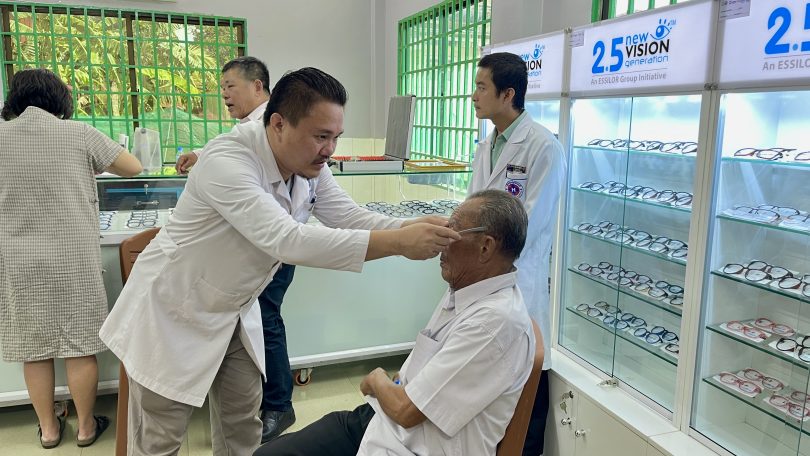The world marked the first ever World Day for Assistive Technology on 4 June, a momentous occasion recognising that assistive technology (AT) transforms lives. Whether it’s glasses, hearing aids, prostheses, or a wheelchair, most people will require AT at some point in their lives.
Today, 2.5 billion people need at least one form of AT. By 2050 this number is likely to rise to 3.5 billion. Appropriate AT can unlock opportunities, enabling greater independence and active participation in society. Yet, millions of people around the world are unable to access the AT they need.
The Australian Government recently pledged to address gaps in access to AT in the Pacific region. It has committed to increasing funding for Pacific countries to screen school-aged children and provide them with essential aids such as glasses, hearing aids and mobility aids.
Addressing the needs of school-aged children is timely and necessary. In many Pacific countries, children with disabilities encounter numerous barriers to education and social participation. Providing glasses, hearing aids, and mobility devices can make a substantial difference in a child’s ability to attend school and engage in daily activities. Vision and hearing impairments, if left unaddressed, can significantly affect educational outcomes and overall development. The commitment to this funding is a welcome step forward. However, it overlooks a demographic with urgent but often neglected needs for such technology: the older population.
The fastest growing unmet AT needs globally are among older people, particularly those living in low- and middle-income settings. The World Health Organization estimates that about two-thirds of the global population aged 60 years or more require AT products. To truly fulfil any commitment to inclusive development, it is essential to recognise and address the needs of older people.
Regional demographics in the Pacific are shifting considerably. Of the one billion older people in the world in 2020, more than half lived in Asia and the Pacific. By 2050, the United Nations Economic and Social Commission for Asia and the Pacific (ESCAP) predicts a doubling of older persons in the region. Notably, older women outnumber men due to their longer life expectancy and are more likely to experience a disability in later life that requires AT.
Older populations in the region encounter substantial barriers to accessing AT, often because of intersecting disadvantages, including ageism and ableism. Consequently, significant gaps exist in policies and programs addressing the AT needs of this diverse group.
AT not only helps fulfil basic needs and maintain independence in older age; it also improves safety and boosts overall mental health and well-being. For instance, hearing aids can improve communication and reduce social isolation and depression and the risk of cognitive decline. Mobility aids such as walkers and wheelchairs can prevent falls and enable older adults to remain active and participate in community life. Glasses can help with daily tasks, enhancing autonomy.
Despite these benefits, AT is often a low priority for governments, development agencies, and donors. Underfunding, limited healthcare infrastructure, and a lack of trained staff hinder access to necessary devices. Where available, AT is often unaffordable, and limited awareness of available options leaves many older people without the AT they need. Those in remote areas face additional challenges, including long and costly journeys to access healthcare services.
Humanitarian emergencies, including frequent climate-related disasters in the region, often increase the need for AT. These emergencies can lead to injuries and the loss or damage of essential items like hearing aids or walking sticks. Unfortunately, older people are also often overlooked in humanitarian responses.
Everyone should have access to safe, appropriate, and affordable AT when they need it, no matter their age, location, gender or income. Lack of AT affects every aspect of life, from accessing food and healthcare to working and participating in the community. Expanding the Australian Government’s current initiative to include older people would enable a more inclusive approach that recognises the diverse needs of people of all age groups.
To create an initiative inclusive of people across the life-course, we encourage the government to build upon its existing investments in AT and consider extending screening programs to include older people; allocating additional funding for AT for older people; training healthcare providers and caregivers to support AT use for older populations (including education on device maintenance); and including older people in monitoring and evaluation processes.
The Australian government’s commitment to supporting Pacific island countries in delivering AT for school-aged children is commendable and marks a significant step towards inclusive development. To build on this progress effectively and address existing inequities, it is crucial to expand coverage to older people. Addressing the needs of this often-overlooked demographic not only enhances their quality of life but also fosters more resilient and inclusive societies in the Asia-Pacific region.
Governments should take the lead in providing assistive technologies, with donors playing a vital supportive role by encouraging and facilitating the development of inclusive AT policies and strategies in partner countries. This collaborative approach, where governments are supported by donors and other stakeholders, will benefit individuals, their families, and communities across all stages of life.


I really agree with this call. My Dad is quite elderly and in the last few years has had to have several hospital stints. In none of them has anyone cared whether his hearing aids are working and being used. Often, they are not. It’s just discrimination and should be unacceptable. As you say an “often overlooked demographic”.